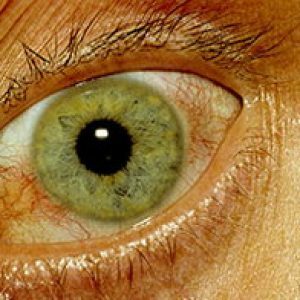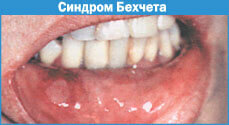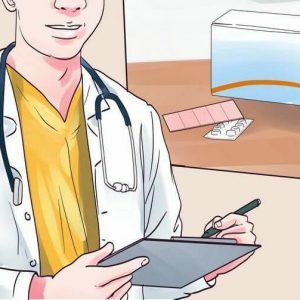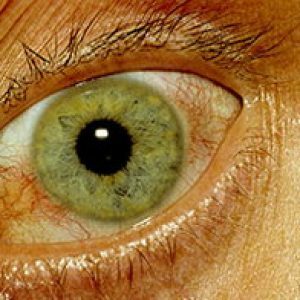Behcet's disease: symptoms and treatment
 Behçet's disease is a rare autoimmune disease in which small and medium vessels are affected, ulcerous processes occur in the genital area and on the mucous membrane of the oral cavity, and uveitis develops( inflammation of the vascular layer of the eye).In connection with the systemic nature of this ailment, internal organs, joints, and the brain can be involved in the pathological process. The middle-aged men, , are most susceptible to the development of Behçet's disease, they have a more severe illness than women and more often lead to death.
Behçet's disease is a rare autoimmune disease in which small and medium vessels are affected, ulcerous processes occur in the genital area and on the mucous membrane of the oral cavity, and uveitis develops( inflammation of the vascular layer of the eye).In connection with the systemic nature of this ailment, internal organs, joints, and the brain can be involved in the pathological process. The middle-aged men, , are most susceptible to the development of Behçet's disease, they have a more severe illness than women and more often lead to death.
Causes and mechanisms of Behçet's disease development
The exact causes of this disease are unknown. However, doctors believe that the following factors are likely to provoke an active autoimmune process leading to inflammation of the vessel walls:
- Chronic infections are herpes simplex, streptococcal tonsillitis.
- Genetic predisposition( there are cases of familial morbidity).
- Exposure to toxic substances.
- Systematic use of alcohol for more than 5 years.
In this pathology, inflammatory changes occur throughout the vascular bed - systemic vasculitis develops, in rare cases even large vessels such as the aorta and pulmonary artery are affected.In addition to blood vessels, autoimmune inflammation affects internal organs, joints, and the brain.
Symptoms of Behçet's disease
The clinical picture of Behcet's disease is polymorphic, since pathological changes occur throughout the body.
Lesion of the skin and mucous membranes is manifested by the following symptoms:
-
 Aftami( small sores) in the oral cavity that can merge, forming large wound surfaces on the mucosa.The course of this stomatitis is protracted, there can be relapses 3-4 times a year.
Aftami( small sores) in the oral cavity that can merge, forming large wound surfaces on the mucosa.The course of this stomatitis is protracted, there can be relapses 3-4 times a year. - Ulcers on the glans penis, on the scrotum, on the labia.
- Nodal erythema - painful red knots on the legs and arms.
- Ugropodobnymi rashes on the skin of the trunk and extremities.
In case of eye damage,
- uveitis occurs.Inflammation of the choroid of the eye can be anterior( irit and iridocyclitis) and posterior, when the retina is involved in the process.
- Conjunctivitis is an inflammation of the conjunctiva.
- Keratitis is an inflammation of the cornea.
- Atrophy of the optic nerve and blindness - in severe cases.
From the side of the vascular bed in Behcet's disease, the following changes occur:
- There are signs of cutaneous vasculitis - a hemorrhagic rash.
- There is a thrombosis of large and small vessels.
- Arterial aneurysms are formed.
It is because of vascular problems( such as thrombosis or aneurysm) that deaths occur in Behcet's disease.The greatest danger is represented by pulmonary arterial thrombosis and aortic aneurysm rupture. When occluding thrombi of the arteries of the legs, development of gangrene is possible.
The defeat of the nervous system in Behcet's disease always has severe manifestations:
- The cerebral membrane or brain tissue is inflamed( these diseases are called meningitis and encephalitis, respectively).
- Increases intracranial pressure.
- There are disorders from the cranial nerves.
- Pareses develop.
- Memory worsens, dementia progresses.
In the pathological process can involve large joints of the limbs and the spine, then the patients begin to complain of pain in the joints, a violation of their mobility.If autoimmune inflammation develops in the vessels of the lungs, patients have hemoptysis, dyspnea, and pulmonary edema is possible.
Kidneys, the gastrointestinal tract and the heart in Behcet's disease are less likely to be affected than the already mentioned organs and systems, but the appearance of pathological symptoms on their part is also possible.Patients may develop a stomach and bowel ulcer, glomerulonephritis, coronary vasculitis, myocarditis, pericarditis, etc.
Diagnosis of Behçet's disease
For patients with suspected Behçet's disease, doctors prescribe a comprehensive examination, the scheme of which is determined by the presence of certain pathological manifestations in the subject.
Compulsory studies include:
- General analysis of blood and urine.
- Biochemical blood test.
- Immunological tests.
- Coagulogram.
- A sample of "patergia"( the patient's skin is pierced with a sterile needle and after 24-48 hours the skin condition is assessed at the injection site, if a rash appears, the test is considered positive).
Recommended for certain symptoms include the following diagnostic methods:
- Study of cerebrospinal fluid.
- Synovial fluid analysis.
- Radiography of the joints, lungs and other organs.
- Angiography.
- CT or MRI to identify the location and nature of pathological changes in the internal organs and brain.
In addition, patients should be consulted by a number of specialists:
- Rheumatologist( this doctor, as a rule, also deals with the treatment of Behcet's disease).
- Dermatologist.
- Immunologist.
- Ophthalmologist.
- The vascular surgeon.
- Neurologist.
- If necessary - urologist, pulmonologist, cardiologist, gynecologist, gastroenterologist.
Diagnostic criteria
When diagnosed as "Behçet's disease", the physician always relies on diagnostic criteria:
- Recurrent aphthous stomatitis.
- Recurrent ulcers of genital organs.
- Specific damage to the eyes - anterior and posterior uveitis, retinal vasculitis.
- Specific lesion of the skin - nodal erythema, acne-like lesions.
- Positive paternity test.
A truly sick person with Behçet's disease should have 3 of the specified criteria, and among them must necessarily be aphthous stomatitis.Otherwise, the doctor should exclude from the patient such diseases as amyloidosis, AIDS, nodular periarteritis, Wegener's granulomatosis, paraneoplastic syndrome, reactive arthritis, malignant neoplasms, ankylosing spondylitis, systemic lupus erythematosus and others.
Treatment of Behçet's disease: the basic principles of
 Behçet's disease is an incurable disease, so the goal of doctors is not to get rid of the disease altogether, but to increase the duration and improve the patient's quality of life, achieve remission, reduce the frequency of exacerbations, and prevent the development of severe complications.
Behçet's disease is an incurable disease, so the goal of doctors is not to get rid of the disease altogether, but to increase the duration and improve the patient's quality of life, achieve remission, reduce the frequency of exacerbations, and prevent the development of severe complications.
Therapeutic measures for Behçet's disease are carried out both in the hospital and outpatient.Indication for hospitalization is the need to diagnose and clarify the diagnosis, as well as exacerbation of the disease and the emergence of complications.
medication therapy is the basis of treatment of the considered pathology, but other methods of treatment may be applied depending on the clinical situation.Due to the simultaneous defeat of many organs and systems by the disease, doctors of different specialties interact with each other and choose the priority direction in the medical process.For example, if large vessels are affected, all efforts are directed to preventing the development of thrombosis or aneurysm.When neurological problems arise, the patient is intensively treated in the neurological department.The same is true for eye, pulmonary and intestinal-gastric manifestations of Behcet's disease.That is, no one is focusing on ulcerative stomatitis, if the patient has hemoptysis, gastrointestinal bleeding, or there is a threat of rupture of the aortic aneurysm.
Drug therapy for Behçet's disease
Patients are prescribed drugs of two groups:
- glucocorticoids;
- immunosuppressants.
Glucocorticoids in Behcet's disease are necessary to reduce the activity of the inflammatory process.Patients are appointed courses.When exacerbation of the disease shows high doses of hormonal drugs, after the onset of remission - supportive or they are generally abolished( all depends on the characteristics of the disease course).
To treat skin manifestations of the disease, hormones are used topically in the form of ointments, and in the case of anterior inflammation of the choroid of the eye - in the form of drops.With severe damage to the organ of vision, glucocorticoids are prescribed and administered.In addition, indications for the systemic use of hormones are neurological, pulmonary, gastrointestinal, articular and serious vascular forms of Behcet's disease.
Task immunosuppressive therapy - to reduce the immune response, which in this pathology is directed against their own tissues.In the course of treatment with immunosuppressive drugs, patients should be protected from infections, as against a decrease in the intensity of immunity even banal ARI can give a bunch of complications.
In addition to these groups of funds, with Behcet's disease, anesthetics and non-steroidal anti-inflammatory drugs, anticoagulants and antiaggregants, interferons and other drugs with immunomodulatory action are used.
It is very important for patients to remember the following:
- Behcet's disease is wavy in nature - remissions alternate with exacerbations.
- The length of relatively healthy periods depends on how the patient complies with the doctor's recommendations( whether the prescribed medication is taken, whether all necessary examinations are performed regularly).
- If you feel worse, exacerbate existing symptoms of the disease or the appearance of new ones, you should immediately contact your doctor.
Forecast
Behcet's disease can occur both in mild form and very hard.Usually the most difficult cases develop at a young age, but the pathology itself rarely causes death. Lethal outcomes, as a rule, occur due to complications from the nervous system and large vessels. In addition, patients with Behcet's disease have a high risk of developing blindness, dementia and other unpleasant consequences.
Zubkova Olga Sergeevna, medical reviewer, epidemiologist-doctor

